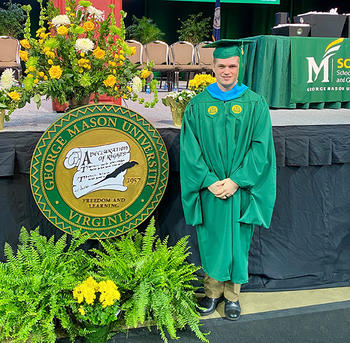In This Story
For Army Major Geoffrey Mattoon, the path to and through higher education wasn’t a straight line; it was a deliberate decision shaped by years of military service, a background in science, and a desire to meet the rising challenges of national security in a tense world.

“I’ve always had an interest in chemistry,” he said. “But once I realized that the math side wasn’t where I wanted to focus, I started looking at how science could be applied more practically. I eventually found that the military and higher education could give me that path.”
Mattoon started his career through a four-year Army scholarship and earned his undergraduate degree in biology from the Rochester Institute of Technology. His first 10 years of service saw him take on various roles, such as logistics, until he found his way to a field that was both intellectually challenging and urgently relevant: the Nuclear and Countering Weapons of Mass Destruction (CWMD) functional area and its Chemical, Biological, Radiological, and Nuclear (CBRN) defense and response efforts.
“CBRN really caught my attention because it requires a different level of critical thinking,” he said. “It’s science through the lens of national security, and that intersection has always fascinated me.”
After a decade of field experience, he was selected for Advanced Civil Schooling, an Army program that allows officers to pursue graduate education in specialized fields aligned with military needs. George Mason University’s Schar School of Policy and Government stood out when choosing where to study.
“I knew I wanted something focused on biodefense and policy—not just technical STEM training,” Mattoon said. “The Schar School offered that balance.”

Unlike other programs in the area he considered, the Schar School’s master of biodefense program provided a curriculum that combined the technical depth of biodefense with the broader strategy of international security. It wasn’t just about how biological threats work; it was about how governments respond, how policy is made, and what happens when things go wrong.
“The reality is, biological defense is one of the hardest CBRN domains to detect and respond to,” Mattoon said. “It’s ambiguous. There’s no one-size-fits-all answer. And that makes it both incredibly challenging and incredibly important.”
The transition from full-time service to graduate school could have been jarring, but for Mattoon, it was energizing. He credits the Schar School with providing an environment where real-world experience wasn’t just welcomed but essential.
“I didn’t come in with a deep academic background in policy,” he said. “But I found a program that helped me bridge my experience in the armed services with deeper insight.”
That bridge started with foundational courses in nonproliferation and strategy, taught by faculty with both academic and operational experience. Professors including Master of Biodefense graduate program Director Gregory Koblentz helped frame current and future biological threats within a historical and geopolitical context, giving Mattoon tools he could immediately apply—not just in theory but in future roles that directly impact national readiness.
“I remember working on a literature review about postattack biodetection systems,” Mattoon said. “It was my first time looking at open-source analysis from a policy angle. That process helped me get back into academic writing, and more importantly, it grounded me in how programs work—or don’t work—at the federal level.”
The Schar School’s location in Northern Virginia, across the Potomac River from Washington, D.C., was another key advantage. Evening classes and hybrid course options allowed Mattoon to balance academic demands with ongoing professional development. Being close to federal agencies, think tanks, and laboratories gave him a clearer sense of how policy is made, debated, and implemented.
“You’re not just studying theory,” he said. “You’re meeting people who are doing the work.”
Mattoon received his master’s degree in May 2024. He is now serving as an Army CBRN plans officer for the U.S. Northern Command in Colorado Springs, Colorado. He is in a position where everything he has studied will translate directly into the defense of the homeland through management of the CBRN Response Enterprise (CRE).
“We talk a lot in this field about preparedness—about saving lives, minimizing human suffering, and ensuring our forces are ready for what comes next,” he said.
He also pointed out that the journey isn’t only for those already in uniform. One of the things he hopes prospective students take away from his story is that there’s no wrong time—or background—to pursue occupations in CBRN defense or response or for the military.
